After Hurricane Helene devastated western North Carolina, towns like Asheville face immense challenges with communication, rescue efforts, and recovery. The storm led to catastrophic flooding, significant fatalities, and widespread infrastructure damage. Over 1,000 inquiries for missing individuals were reported in Buncombe County. With over 400 roads closed and further rain anticipated, the road to recovery remains uncertain as communities grapple with loss and seek to reclaim their spirit.
In the aftermath of Hurricane Helene, small towns across western North Carolina face significant challenges with communication and recovery. After making landfall in Florida as a Category 4 storm, Helene unleashed torrential rain across multiple states, resulting in catastrophic flooding. The devastation is evident as residents struggle to reach loved ones, with Buncombe County reporting over 1,000 inquiries concerning missing individuals. Communication remains sporadic, complicating rescue efforts and information dissemination. In North Carolina alone, at least 10 fatalities have been confirmed, with South Carolina experiencing the highest death toll at 22. Emergency services are battling road closures, with over 400 roads impassable, including major highways critical for transportation in and out of affected areas. Access to certain neighborhoods has been severely hindered, forcing search-and-rescue teams to adapt their strategies amidst the ruins of what were once thriving communities. Despite being a week since the hurricane, various flood alerts remain in effect, reflecting ongoing threats to public safety. Residents in flooded regions, such as Asheville, confront the stark realities of lost infrastructure and livelihoods as they begin to assess the extent of the damage. With further rainfall expected in the coming days, concerns about additional flooding and runoff persist, intensifying fears about the recovery process for these communities. Amidst the widespread disarray, local artists and neighbors cling to hope, recounting memories of their cherished connections to the area and expressing optimism for a future rejuvenated by resilience and community spirit.
The article highlights the severe impact of Hurricane Helene on communities in North Carolina, detailing the extensive flooding that followed the storm. As a notable weather event, Hurricane Helene transitioned from a powerful hurricane on the Gulf Coast to a storm causing widespread devastation in the Appalachians. Communication disruptions and transportation hurdles exacerbate rescue efforts and damage assessments, prompting critical conversations about infrastructure and community resilience in the face of natural disasters. The ongoing situation underscores the vulnerability of this region to extreme weather events and the resulting long-term consequences for its residents.
In summary, the aftermath of Hurricane Helene has cast a long shadow over western North Carolina, where communication struggles hamper rescue and recovery efforts, and fatalities are reported across affected states. The extensive road closures and destruction of neighborhoods intensify the sense of urgency within the region, while community members express their lingering hope for recovery and renewal. As additional rain threatens to impact already saturated soils, local authorities and citizens alike remain vigilant in their efforts to rebuild their lives and restore their vibrant communities.
Original Source: www.washingtonpost.com




